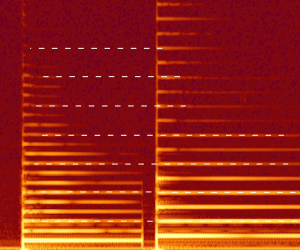Mersenne's laws

Mersenne's laws are laws describing the frequency of oscillation of a stretched string.[1] The equation was first proposed by French mathematician and music theorist Marin Mersenne in his 1637 work Traité de l'harmonie universelle.[2] Mersenne's laws govern the construction and operation of string instruments, pianos, harps, which must accommodate the total tension force required to keep the strings at the proper pitch. Lower strings are thicker, thus having a greater mass per unit length. They typically have lower tension. Higher-pitched strings typically are thinner, have higher tension, and may be shorter.
Equations
The fundamental frequency is:
- a) Inversely proportional to the length of the string,
- b) Proportional to the square root of the stretching force, and
- c) Inversely proportional to the square root of the mass per unit length.
 (equation 26)
(equation 26)
 (equation 27)
(equation 27)
 (equation 28)
(equation 28)
Thus, for example, all other properties of the string being equal, to make the note one octave higher one would need either to halve its length, or to increase the tension by a factor of 4, or to decrease its mass per unit length by a factor of 4.
These laws are derived from Mersenne's equation 22:[3]
The formula for the fundamental frequency is:
where f is the frequency, L is the length, F is the force and μ is the mass per unit length.
See also
References
- ↑ Jeans, James H. (1968). Science and Music, . Dover, ISBN 978-0486619644. Cited in "Mersenne's Laws", Wolfram.com.
- ↑ Mersenne, Marin (1637). Traité de l'harmonie universelle, . via the Bavarian State Library. Cited in "Mersenne's Laws", Wolfram.com.
- ↑ Steinhaus, Hugo (1999). Mathematical Snapshots, . Dover, ISBN 9780486409146. Cited in "Mersenne's Laws", Wolfram.com.
| ||||||||||||||||||||||||


